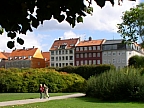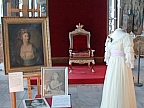A
Royal ceremony in 1660 was held outside of the square
of ancient Copenhagen Castle, on the right of the painting
by Heinrich Hansen, to acclaim King Frederik III as
the heir to the throne. King Christian IV lived here
until he moved out to his is little summer residence
- Rosenborg. In the middle of the painting is the Old
Stock Exchange from 1620, and on the left the naval
church “Holmens Kirke” inaugurated in 1619.
Both properties were built by King Christian IV. |
|
King
Christian IV’s birthplace Frederiksborg Castle
was rebuilt by the King at the beginning of the 17th
century and was used as a Royal residence until the
Royal Family moved into Rosenborg Castle around 1610.
In 1850s the Castle was again used by King Frederik
VII as a Royal residence and in 1859, while he was in
residence - a heavy fire destroyed almost all of the
Castles interior and other valuable artefacts. Today
- the Castle houses the Museum of National History.
|
|









